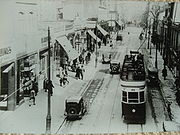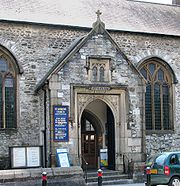
Plymouth Blitz
Encyclopedia


Strategic bombing during World War II
Strategic bombing during World War II is a term which refers to all aerial bombardment of a strategic nature between 1939 and 1945 involving any nations engaged in World War II...
carried out by the Nazi German Luftwaffe
Luftwaffe
Luftwaffe is a generic German term for an air force. It is also the official name for two of the four historic German air forces, the Wehrmacht air arm founded in 1935 and disbanded in 1946; and the current Bundeswehr air arm founded in 1956....
on the English
England
England is a country that is part of the United Kingdom. It shares land borders with Scotland to the north and Wales to the west; the Irish Sea is to the north west, the Celtic Sea to the south west, with the North Sea to the east and the English Channel to the south separating it from continental...
city of Plymouth
Plymouth
Plymouth is a city and unitary authority area on the coast of Devon, England, about south-west of London. It is built between the mouths of the rivers Plym to the east and Tamar to the west, where they join Plymouth Sound...
in the Second World War. The bombings launched on numerous British cities were known as the Blitz
The Blitz
The Blitz was the sustained strategic bombing of Britain by Nazi Germany between 7 September 1940 and 10 May 1941, during the Second World War. The city of London was bombed by the Luftwaffe for 76 consecutive nights and many towns and cities across the country followed...
.
The royal dockyards at HMNB Devonport
HMNB Devonport
Her Majesty's Naval Base Devonport , is one of three operating bases in the United Kingdom for the Royal Navy . HMNB Devonport is located in Devonport, in the west of the city of Plymouth in Devon, England...
were the main target in order to facilitate Nazi German domination during the Battle of the Atlantic. Despite this, civilian casualties
Civilian casualties
Civilian casualties is a military term describing civilian or non-combatant persons killed, injured, or imprisoned by military action. The description of civilian casualties includes any form of military action regardless of whether civilians were targeted directly...
were very high and the dockyards continued in operation. The first bombs fell on the city on Saturday 6 July 1940 at Swilly, killing 3 people. In early 1941, five raids reduced much of the city to rubble. The last attack came on 30 April 1944. During the 59 bombing attacks, 1,172 civilians were killed and 4,448 injured.
The resident population fell from 220,000 at the outbreak of war to, at one point, only 127,000. In 1941 most of the children were evacuated
Evacuations of civilians in Britain during World War II
Evacuation of civilians in Britain during the Second World War was designed to save the population of urban or military areas in the United Kingdom from aerial bombing of cities and military targets such as docks. Civilians, particularly children, were moved to areas thought to be less at risk....
and on any night that a raid was expected thousands of people were taken by lorry into the countryside, usually to the fringes of Dartmoor
Dartmoor
Dartmoor is an area of moorland in south Devon, England. Protected by National Park status, it covers .The granite upland dates from the Carboniferous period of geological history. The moorland is capped with many exposed granite hilltops known as tors, providing habitats for Dartmoor wildlife. The...
.
In March 1941, St Andrew's Parish Church
St Andrew's Church, Plymouth
St Andrew's Church, Plymouth is an Anglican church in Plymouth. It is the original parish church of Sutton, one of the three towns which were later combined to form the city of Plymouth. The church is the largest parish church in the historic county of Devon and was built in the mid to late 15th...
was bombed and badly damaged. Amidst the smoking ruins a headmistress nailed over the door a wooden sign saying simply Resurgam (Latin for I shall rise again), indicating the wartime spirit, a gesture repeated at other devastated European churches. That entrance to St Andrew's is still referred to as the "Resurgam" door and a carved granite plaque is now permanently fixed there.
Charles Church
Charles Church, Plymouth, Devon
Charles Church is the second most ancient Parish Church in Plymouth, Devon in England. The senior church is St Andrew's Church, the Mother Church of Plymouth....
, destroyed by incendiaries on the nights of 20-21 March 1941, has been preserved in its ruined state as a memorial to civilian victims of the Blitz.
On the evening of 22 April 1941 during an attack on the central area, the communal air-raid shelter
Air-raid shelter
Air-raid shelters, also known as bomb shelters, are structures for the protection of the civil population as well as military personnel against enemy attacks from the air...
at Portland Square took a direct hit which killed 72 people. In the early 2000s this was commemorated by the University of Plymouth
University of Plymouth
Plymouth University is the largest university in the South West of England, with over 30,000 students and is 9th largest in the United Kingdom by total number of students . It has almost 3,000 staff...
, which named a new building on the site after the incident, and also commissioned a local artist to create a commemorative piece.
During the Blitz the two main shopping centres and nearly every civic building were destroyed, along with 26 schools, eight cinemas and 41 churches. In total, 3,754 houses were destroyed with a further 18,398 seriously damaged.

